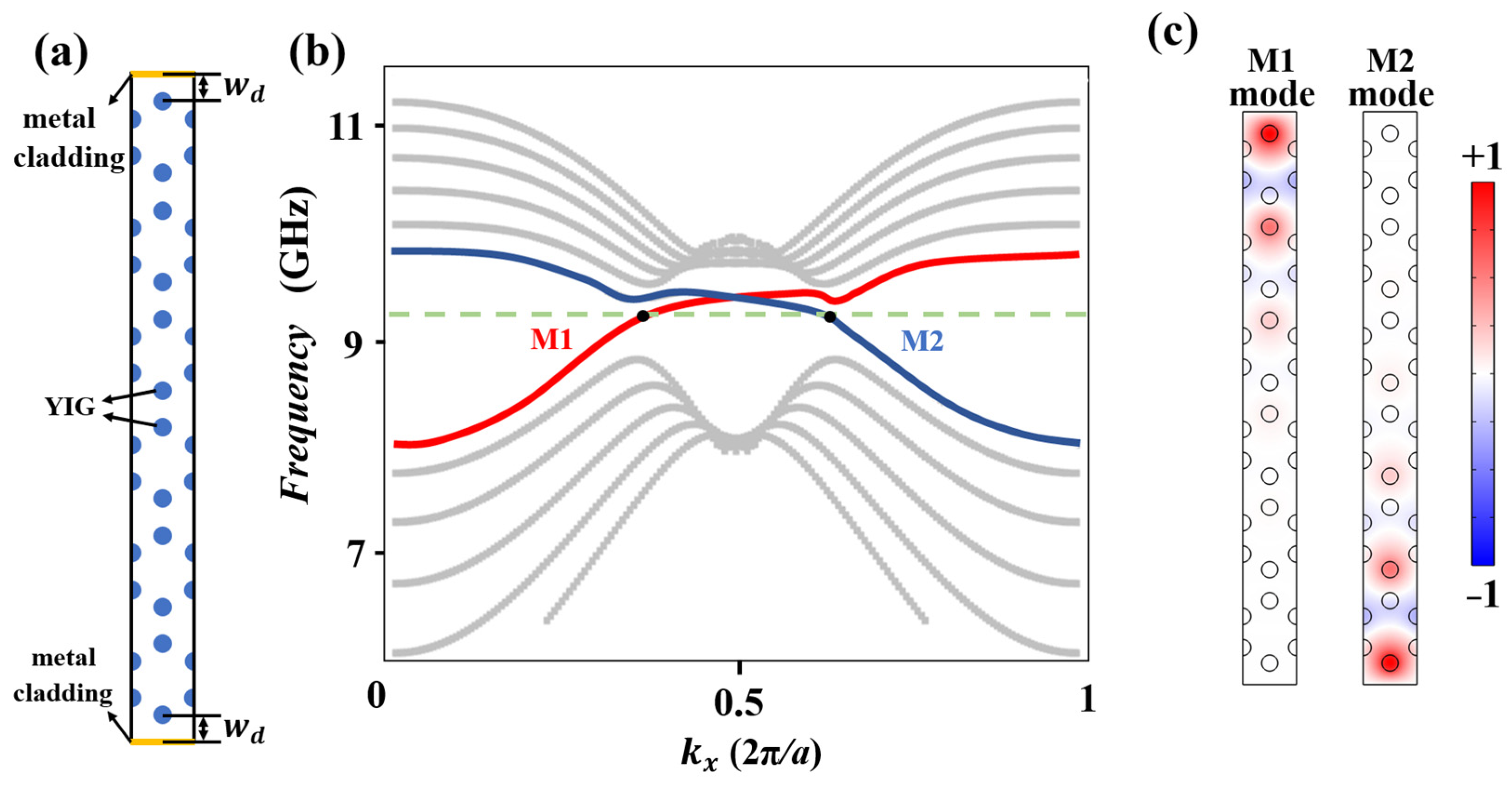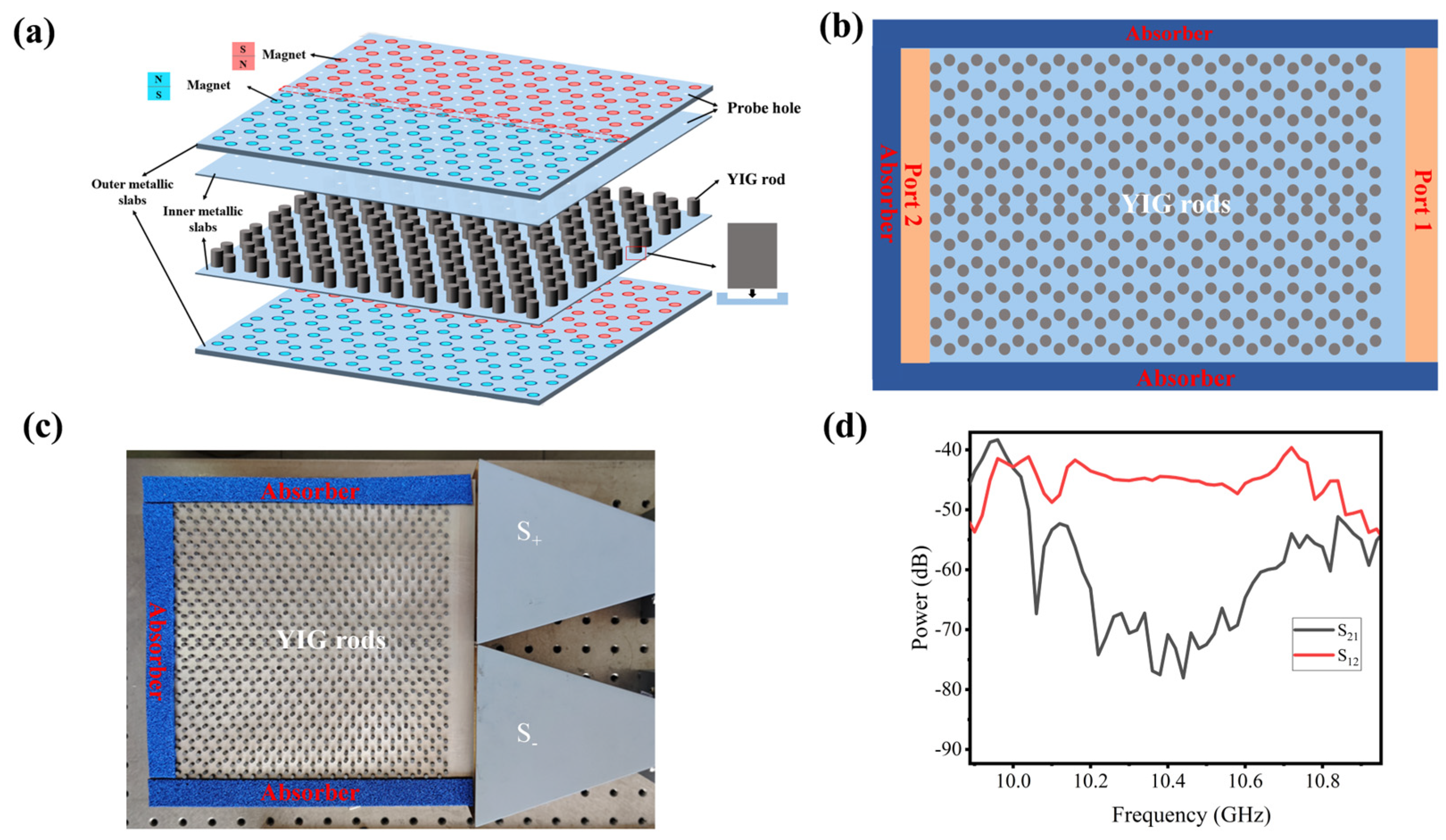Extended One-Way Waveguide States of Large-Area Propagation in Gyromagnetic Photonic Crystals
Abstract
:1. Introduction
2. Materials and Methods
2.1. Basic GPC Structure
2.2. Projected Band Structure and Physical Mechanism Analysis
2.3. Design of Experiment Scheme
3. Results
3.1. Numerical Simulations of the One-Way Large-Area Waveguide Extended States
3.2. Experimental Results of the One-Way Large-Area Waveguide Extended States
4. Conclusions
Author Contributions
Funding
Data Availability Statement
Conflicts of Interest
References
- John, S. Strong Localization of Photons in Certain Disordered Dielectric Super Lattices. Phys. Rev. Lett. 1987, 58, 2486–2489. [Google Scholar] [CrossRef] [PubMed]
- Yablonovitch, E. Inhibited spontaneous emission in solid-state physics and electronics. Phys. Rev. Lett. 1987, 58, 2059–2062. [Google Scholar] [CrossRef] [PubMed]
- Haldane, F.D.M.; Raghu, S. Possible realization of directional optical waveguides in photonic crystals with broken time-reversal symmetry. Phys. Rev. Lett. 2008, 100, 013904. [Google Scholar] [CrossRef] [PubMed]
- Raghu, S.; Haldane, F.D.M. Analogs of quantum-Hall-effect edge states in photonic crystals. Phys. Rev. A 2008, 78, 033834. [Google Scholar] [CrossRef]
- Wu, L.-H.; Hu, X. Scheme for Achieving a Topological Photonic Crystal by Using Dielectric Material. Phys. Rev. Lett. 2015, 114, 223901. [Google Scholar] [CrossRef]
- Dong, J.W.; Chen, X.D.; Zhu, H.; Wang, Y.; Zhang, X. Valley photonic crystals for control of spin and topology. Nat. Mater. 2017, 16, 298–302. [Google Scholar] [CrossRef]
- Gao, F.; Xue, H.; Yang, Z.; Lai, K.; Yu, Y.; Lin, X.; Chong, Y.; Shvets, G.; Zhang, B. Topologically protected refraction of robust kink states in valley photonic crystals. Nat. Phys. 2017, 14, 140–144. [Google Scholar] [CrossRef]
- He, X.T.; Liang, E.T.; Yuan, J.J.; Qiu, H.Y.; Chen, X.D.; Zhao, F.L.; Dong, J.W. A silicon-on-insulator slab for topological valley transport. Nat. Commun. 2019, 10, 872. [Google Scholar] [CrossRef]
- Fukui, T.; Hatsugai, Y.; Suzuki, H. Chern Numbers in Discretized Brillouin Zone: Efficient Method of Computing (Spin) Hall Conductances. J. Phys. Soc. Jpn. 2005, 74, 1674–1677. [Google Scholar] [CrossRef]
- Bahari, B.; Ndao, A.; Vallini, F.; El Amili, A.; Fainman, Y.; Kante, B. Nonreciprocal lasing in topological cavities of arbitrary geometries. Science 2017, 358, 636–639. [Google Scholar] [CrossRef]
- Shao, Z.K.; Chen, H.Z.; Wang, S.; Mao, X.R.; Yang, Z.Q.; Wang, S.L.; Wang, X.X.; Hu, X.; Ma, R.M. A high-performance topological bulk laser based on band-inversion-induced reflection. Nat. Nanotechnol. 2020, 15, 67–72. [Google Scholar] [CrossRef] [PubMed]
- Zeng, Y.; Chattopadhyay, U.; Zhu, B.; Qiang, B.; Li, J.; Jin, Y.; Li, L.; Davies, A.G.; Linfield, E.H.; Zhang, B.; et al. Electrically pumped topological laser with valley edge modes. Nature 2020, 578, 246–250. [Google Scholar] [CrossRef] [PubMed]
- Liu, S.Y.; Lu, W.L.; Lin, Z.F.; Chui, S.T. Magnetically controllable unidirectional electromagnetic waveguiding devices designed with metamaterials. Appl. Phys. Lett. 2010, 97, 201113. [Google Scholar] [CrossRef]
- He, C.; Chen, X.L.; Lu, M.H.; Li, X.F.; Wan, W.W.; Qian, X.S.; Yin, R.C.; Chen, Y.F. Tunable one-way cross-waveguide splitter based on gyromagnetic photonic crystal. Appl. Phys. Lett. 2010, 96, 111111. [Google Scholar] [CrossRef]
- Tang, G.; Huang, Y.; Chen, J.; Li, Z.-Y.; Liang, W. A Topological Multichannel Add-Drop Filter Based on Gyromagnetic Photonic Crystals. Nanomaterials 2023, 13, 1711. [Google Scholar] [CrossRef]
- Tao, K.; Xiao, J.-J.; Yin, X. Nonreciprocal photonic crystal add-drop filter. Appl. Phys. Lett. 2014, 105, 211105. [Google Scholar] [CrossRef]
- Yan, C.; Huang, Y.; Li, Z.Y.; Liang, W. Controllable Pseudospin Topological Add-Drop Filter Based on Magnetic-Optical Photonic Crystals. Nanomaterials 2024, 14, 919. [Google Scholar] [CrossRef]
- Chen, J.F.; Liang, W.Y.; Li, Z.Y. Antichiral one-way edge states in a gyromagnetic photonic crystal. Phys. Rev. B 2020, 101, 214102. [Google Scholar] [CrossRef]
- Zhou, P.H.; Liu, G.G.; Yang, Y.H.; Hu, Y.H.; Ma, S.L.; Xue, H.R.; Wang, Q.; Deng, L.J.; Zhang, B.L. Observation of Photonic Antichiral Edge States. Phys. Rev. Lett. 2020, 125, 263603. [Google Scholar] [CrossRef]
- Yu, Z.; Veronis, G.; Wang, Z.; Fan, S. One-Way Electromagnetic Waveguide Formed at the Interface between a Plasmonic Metal under a Static Magnetic Field and a Photonic Crystal. Phys. Rev. Lett. 2008, 100, 023902. [Google Scholar] [CrossRef]
- Chen, J.; Li, Z.-Y. Configurable topological beam splitting via antichiral gyromagnetic photonic crystal. Opto-Electron. Sci. 2022, 1, 220001. [Google Scholar] [CrossRef]
- Chen, J.F.; Li, Z.Y. Prediction and Observation of Robust One-Way Bulk States in a Gyromagnetic Photonic Crystal. Phys. Rev. Lett. 2022, 128, 257401. [Google Scholar] [CrossRef] [PubMed]
- Wang, M.; Zhang, R.Y.; Zhang, L.; Wang, D.; Guo, Q.; Zhang, Z.Q.; Chan, C.T. Topological One-Way Large-Area Waveguide States in Magnetic Photonic Crystals. Phys. Rev. Lett. 2021, 126, 067401. [Google Scholar] [CrossRef]
- Qu, T.; Wang, N.; Wang, M.; Zhang, L.; Chen, J. Flexible electromagnetic manipulation by topological one-way large-area waveguide states. Phys. Rev. B 2022, 105, 195432. [Google Scholar] [CrossRef]
- Lan, Z.; Chen, M.L.N.; You, J.W.; Sha, W.E.I. Large-area quantum-spin-Hall waveguide states in a three-layer topological photonic crystal heterostructure. Phys. Rev. A 2023, 107, L041501. [Google Scholar] [CrossRef]
- Chen, Q.; Zhang, L.; Chen, F.; Yan, Q.; Xi, R.; Chen, H.; Yang, Y. Photonic Topological Valley-Locked Waveguides. ACS Photonics 2021, 8, 1400–1406. [Google Scholar] [CrossRef]
- Yu, X.; Chen, J.; Li, Z.-Y.; Liang, W. Topological large-area one-way transmission in pseudospin-field-dependent waveguides using magneto-optical photonic crystals. Photonics Res. 2023, 11, 1105–1112. [Google Scholar] [CrossRef]
- Wang, Z.; Chong, Y.D.; Joannopoulos, J.D.; Soljacic, M. Observation of unidirectional backscattering-immune topological electromagnetic states. Nature 2009, 461, 772–775. [Google Scholar] [CrossRef]
- Chen, J.F.; Liang, W.Y.; Li, Z.Y. Progress of Topological Photonic State in Magneto-Optical Photonic Crystal. Acta Opt. Sin. 2021, 41, 0823015. [Google Scholar]
- Skirlo, S.A.; Lu, L.; Igarashi, Y.C.; Yan, Q.H.; Joannopoulos, J.; Soljacic, M. Experimental Observation of Large Chern Numbers in Photonic Crystals. Phys. Rev. Lett. 2015, 115, 253901. [Google Scholar] [CrossRef]
- Zhao, R.; Xie, G.D.; Chen, M.L.N.; Lan, Z.; Huang, Z.; Sha, W.E.I. First-principle calculation of Chern number in gyrotropic photonic crystals. Opt. Express 2020, 28, 4638–4649. [Google Scholar] [CrossRef]






Disclaimer/Publisher’s Note: The statements, opinions and data contained in all publications are solely those of the individual author(s) and contributor(s) and not of MDPI and/or the editor(s). MDPI and/or the editor(s) disclaim responsibility for any injury to people or property resulting from any ideas, methods, instructions or products referred to in the content. |
© 2024 by the authors. Licensee MDPI, Basel, Switzerland. This article is an open access article distributed under the terms and conditions of the Creative Commons Attribution (CC BY) license (https://creativecommons.org/licenses/by/4.0/).
Share and Cite
Li, X.; Yan, C.; Li, Z.-Y.; Liang, W. Extended One-Way Waveguide States of Large-Area Propagation in Gyromagnetic Photonic Crystals. Nanomaterials 2024, 14, 1790. https://doi.org/10.3390/nano14221790
Li X, Yan C, Li Z-Y, Liang W. Extended One-Way Waveguide States of Large-Area Propagation in Gyromagnetic Photonic Crystals. Nanomaterials. 2024; 14(22):1790. https://doi.org/10.3390/nano14221790
Chicago/Turabian StyleLi, Xiaobin, Chao Yan, Zhi-Yuan Li, and Wenyao Liang. 2024. "Extended One-Way Waveguide States of Large-Area Propagation in Gyromagnetic Photonic Crystals" Nanomaterials 14, no. 22: 1790. https://doi.org/10.3390/nano14221790
APA StyleLi, X., Yan, C., Li, Z.-Y., & Liang, W. (2024). Extended One-Way Waveguide States of Large-Area Propagation in Gyromagnetic Photonic Crystals. Nanomaterials, 14(22), 1790. https://doi.org/10.3390/nano14221790






